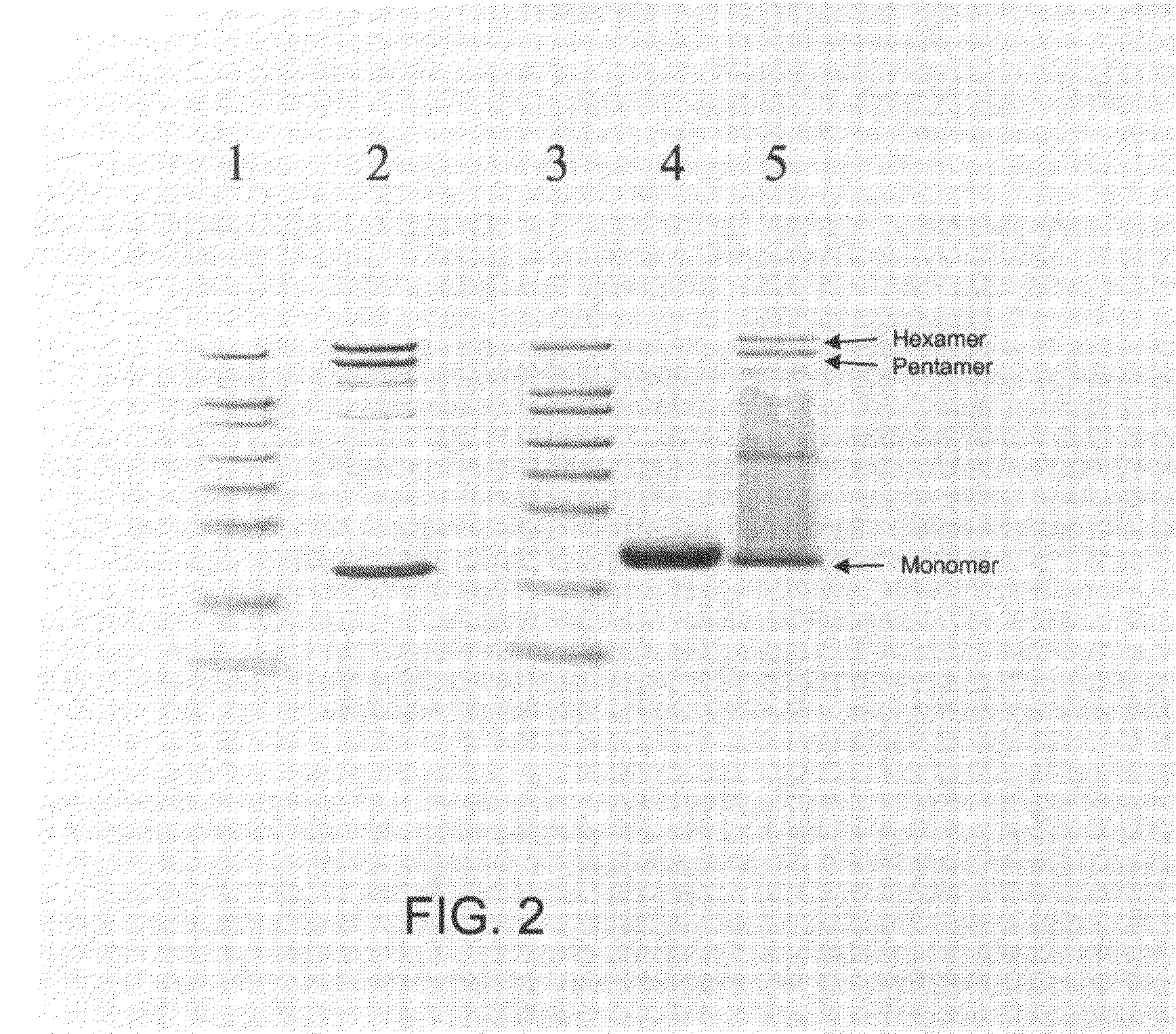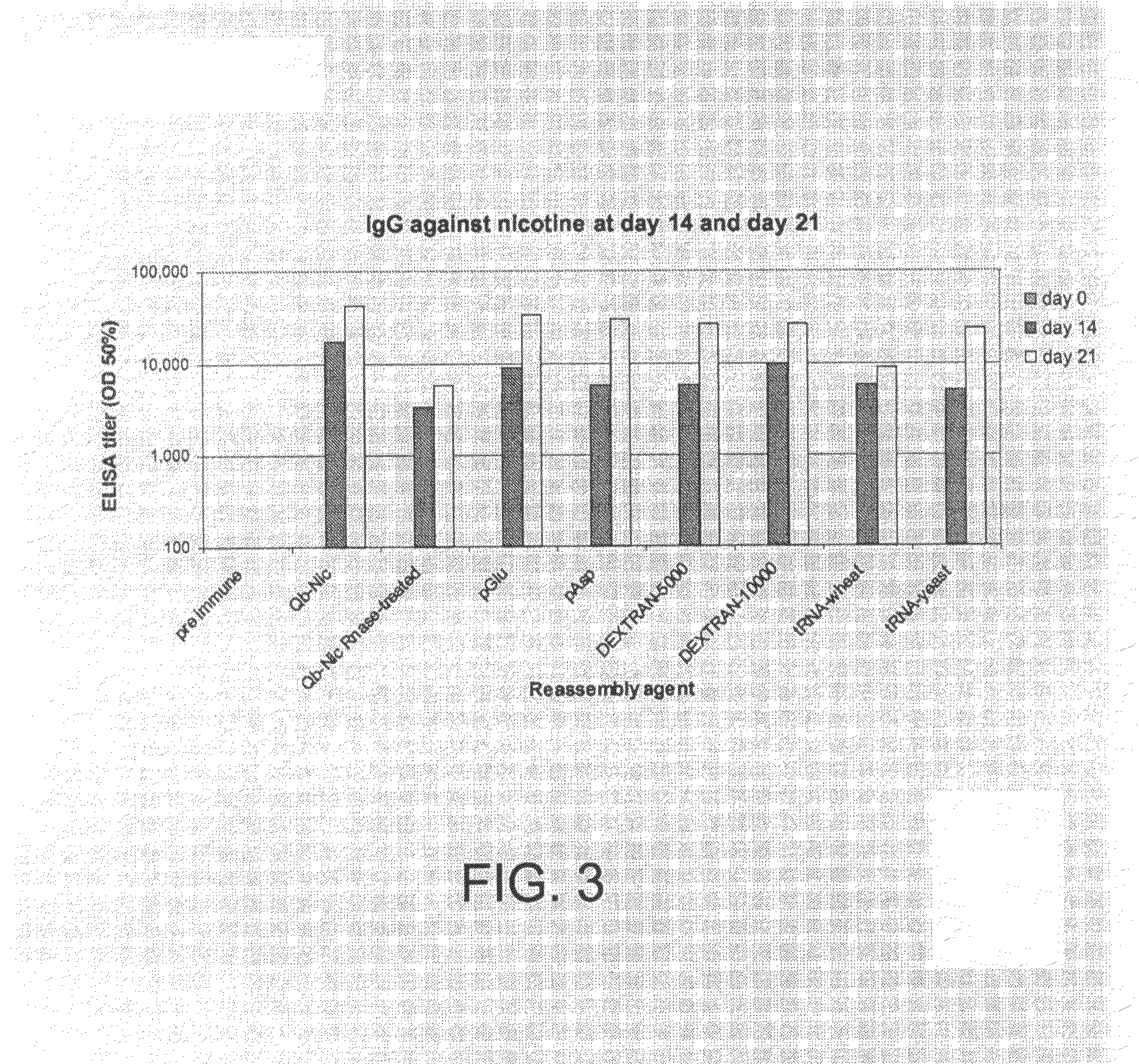VLP-antigen conjugates and their uses as vaccines
a technology of antigen conjugates and conjugates, which is applied in the field of molecular biology, virology, immunology and medicine, can solve the problems of undesired presence of substances such as unidentified bacterial components beside the proven pharmaceutically active ingredients of vaccines, and achieve the effect of minimizing or avoiding unwanted t cell responses or other unwanted side effects
- Summary
- Abstract
- Description
- Claims
- Application Information
AI Technical Summary
Benefits of technology
Problems solved by technology
Method used
Image
Examples
example 1
Expression of Qβ Coat Protein and Purification of the Resulting Prior Art Qβ VLP
[0201]E. coli JM109 was transformed with Qβ coat protein expressing plasmids. 5 ml of LB liquid medium containing 20 μg / ml ampicillin was inoculated with a clone transformed with Qβ coat protein expression plasmid. The inoculated culture was incubated at 37° C. for 16-24 hours without shaking. The culture was subsequently diluted 1:100 in 100-300 ml of fresh LB medium, containing 20 μg / ml ampicillin, and incubated at 37° C. overnight without shaking. The resulting second inoculum was diluted 1:50 in M9 medium containing 1% Casamino acids and 0.2% glucose in flasks, and incubated at 37° C. overnight under shaking. The cells were pelleted by centrifugation and frozen for storage.
[0202]Purification
[0203]Solutions and buffers for the purification procedure:
[0204]1. Lysis buffer LB[0205]50 mM Tris-HCl pH8.0 with 5 mM EDTA, 0.1% tritonX100 and freshly prepared PMSF at a concentration of 5 micrograms per ml wit...
example 2
Hydrolysis of RNA Encapsulated in Prior Art Qβ VLPs by RNAse A
[0220]Prior art Qβ VLPs at a concentration of 1.0 mg / ml in 0.2×HBS (4 mM HEPES, 30 mM NaCl, pH 7.4) were digested by addition of RNaseA (Qiagen AG, Switzerland) to a final concentration of 300 μg / ml. The sample was incubated for 3 h at 37° C. in a thermomixer at 650 rpm. Then the sample was dialyzed against 0.2 HBS buffer in a 300,000 molecular weight cutoff membrane overnight with one time exchange of buffer. An adequate portion of prior art Qβ VLPs from the same batch was not treated with RNaseA but rather saved for the determination of the amount of RNA, preferably nucleic acids, in the subsequent procedure.
[0221]To determine the amount of RNA, preferably nucleic acids, with secondary structure remained within the VLPs, equal amounts (by weight) of RNaseA-treated Qβ VLPs and prior art Qβ VLPs not being treated with RNaseA were loaded on a 1% agarose gel containing ethidium bromide (typically and preferably at a concent...
example 3
Non-Enzymatic Hydrolysis of the RNA Content of VLPs
ZnSO4 Dependent Degradation of the Nucleic Acid Content of a VLP:
[0223]Prior art Qβ VLPs (1.0 mg / ml in 0.2×HBS buffer) was incubated in the presence of 2.5 mM ZnSO4 at 60° C. for 24 h. The resulting sample was dialyzed against 0.2 HBS buffer in a 300,000 molecular weight cutoff membrane overnight with one time of exchanging buffer. An adequate portion of prior art Qβ VLPs from the same batch was not treated with ZnSO4 but rather saved for the determination of the amount of RNA, preferably nucleic acids, with secondary structure in the subsequent procedure.
[0224]To determine the amount of RNA, preferably nucleic acid, with secondary structures remained within the VLPs, equal amounts (by weight) of ZnSO4-treated Qβ VLPs and prior art Qβ VLPs not being treated with ZnSO4 were loaded on a 1% agarose gel containing ethidium bromide (typically and preferably at a concentration of 0.5 μg / ml), which intercalates into the secondary structure...
PUM
 Login to View More
Login to View More Abstract
Description
Claims
Application Information
 Login to View More
Login to View More - R&D
- Intellectual Property
- Life Sciences
- Materials
- Tech Scout
- Unparalleled Data Quality
- Higher Quality Content
- 60% Fewer Hallucinations
Browse by: Latest US Patents, China's latest patents, Technical Efficacy Thesaurus, Application Domain, Technology Topic, Popular Technical Reports.
© 2025 PatSnap. All rights reserved.Legal|Privacy policy|Modern Slavery Act Transparency Statement|Sitemap|About US| Contact US: help@patsnap.com



